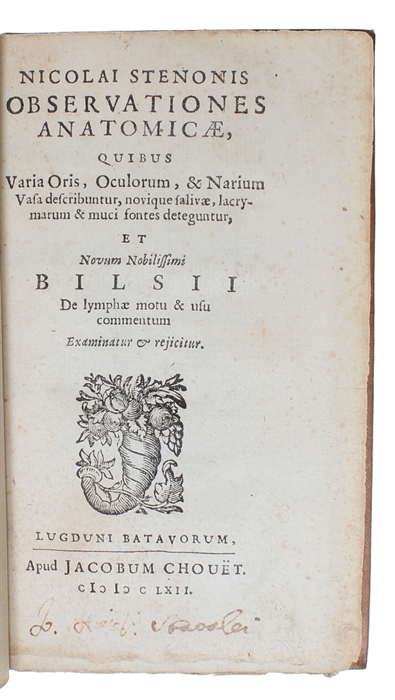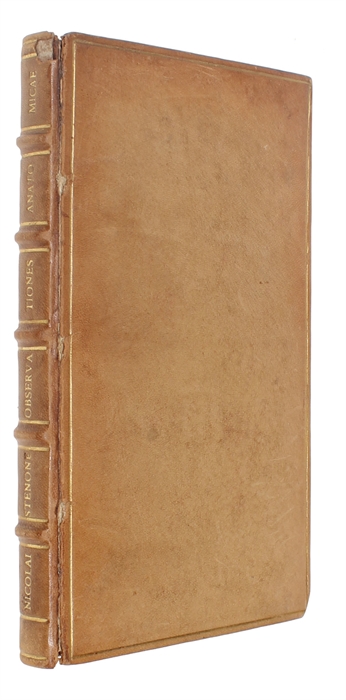THE FOUNDATION OF THE STUDY OF GLANDS AS A SCIENCE
STENO, NICOLAI (NIELS STENSEN).
Observationes Anatomicae.
Lugduni [Leiden], Jacobum Chouët, 1662.
12mo. Partly uncut in a nice later full calf binding (19th century?) with five raised bands and gilt lettering to spine. Hinges with a bit of wear and small piece of leather lacking on top of spine. Vague previous owner's name in contemporary hand to lower part of title-page. Ex-libris pasted on to pasted down front end-paper. Vague traces after stamp on p. 108. A fine copy. (12), 108 pp. + 3 folded plates.
The rare first edition of Steno's early and first major discovery, being the findings of the 3 main Ducts and glands of the eye, the mouth and the nose, among these the first account of the excretory duct of the parotid gland now named "Stensen's Duct". He correctly stated that the true purpose of the glands was to secrete fluid and "with [the present work] Nicolaus Steno had established the study of glands as a science". (Snorrason).
His careful dissections of animal, and later human, brains were revolutionary. He demonstrated that tears are secrated by specific glands, thus striking a deadly blow to the ancient notion of cerebral excretion, even disproving the speculations of scholars such as Descartes, who believed that the corpus pineale (a brain gland) was the connecting point between soul and body.
Steno arrived in Holland in March 1660 and was given lodging by the city's physician Gerad Blaes (Latin: Blasius) who himself had studied in Copenhagen and was a friend of Thomas Bartholin. A year later Steno wrote in a letter to Bartholin:
"After I had been given leave by Blasius to dissect on my own in the museum, I bought a sheep's-head in order to examine the brain. I happened to decide to investigate first the course of the veins and arteries at the mouth by introducing a probe into the vessels. I suddenly discovered that the point of the probe was moving freely in a spacious cavity and struck with a ringing sound against the teeth. Surprised at this, I called my host to hear his opinion. Blasius first said that it was due to force, then that it was one of nature's frequent freaks, and finally he looked up Wharton's book, but found no explanation there".
Shortly thereafter, Steno repeated the investigation on a dog and confirmed, "there was a duct leading from the gland by the ear to the oral cavity, of a similar kind to the duct from the submaxillary gland found by the English man Thomas Wharton (1610-1673) a few years previously and described in his book Adenographia 1656. Steno was now certain that the gland was a salivary gland and not, as Wharton said in his book and as had been believed for some 1500 year, a kind of sponge intended to absorb surplus materials from the hard rami of the fifth pair of nerves, carry these back to the veins, warm up the outer and inner ear, and fill up the hollow around them." (Snorrason).
"This discovery led Stensen to consider every fluid in the body as a glandular secretion. He then found a series of glands furnishing fluid to each of the body cavities. He likewise sought the afferent and efferent ducts of secretion. Stensen still used the name "lymph" for all watery glandular secretions, because he was not yet able to differentiate between them and to specify them chemically and physiologically. In the course of this basic research Stensen presented in his Leiden dissertation new discoveries of glands in the cheeks; beneath the tongue; and in the palate, whose structure of veins, arteries, nerves, and lymph vessels he also described. In his Observationes anatomicae (1662), dealing with his new discoveries concerning the glands, he described the lachrymal apparatus in great detail." DSB 13, 33.
"Niels Stensen remains one of the most notable scientists in the history of anatomy. His method based on dissection and experiment enabled him to make significant contribution to the understanding of structure and function of human body. Like many successful scientists he was able to make the most of the rather serendipitous discovery of the parotid duct early in his career, soon expanding his research focus into new areas." (Strkalj, Niels Stensen and the Discovery of the Parotid Duct).
"In the physiology his researches into the anatomy of the glands led to his discovery of the [duct of] parotid gland, one of the three salivary glands near the ear, into the mouth, is still named "Steno's duct."" (PMM 151)
Osler 4018
Garrison & Morton 973
Waller 9226
Heirs of Hippocrates 393
Norman 2010
Snorrason 1662
(PMM 151)
Order-nr.: 53846



